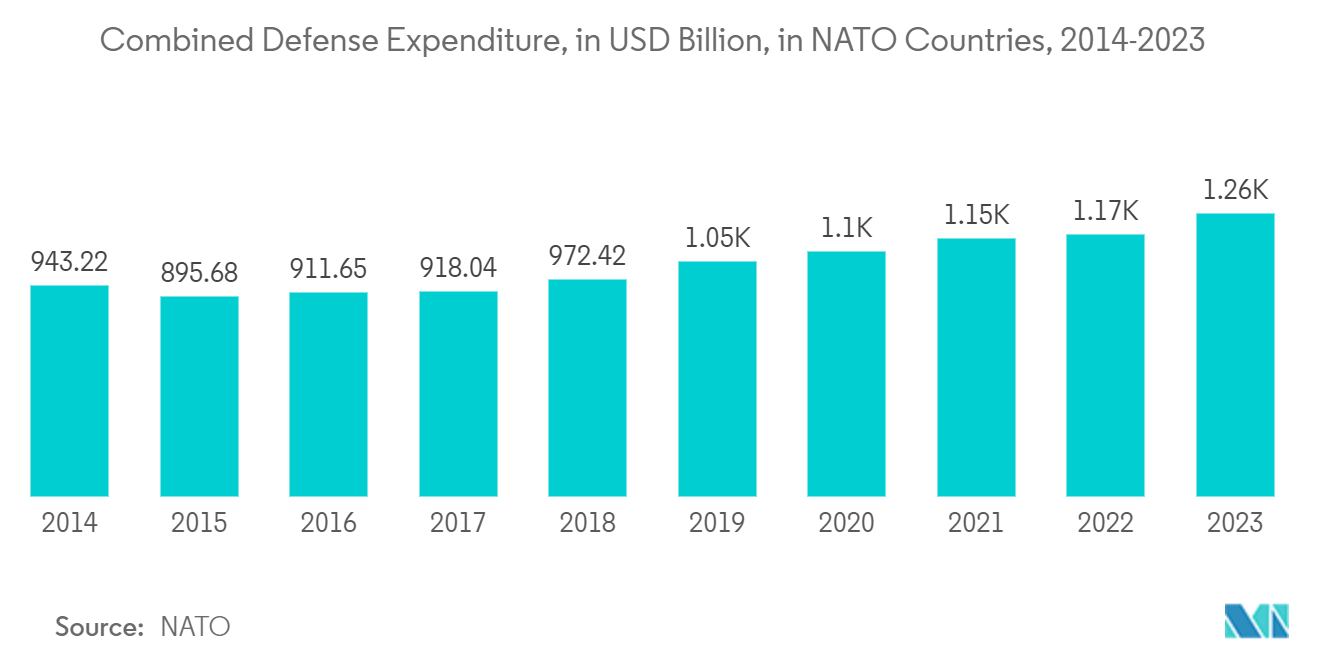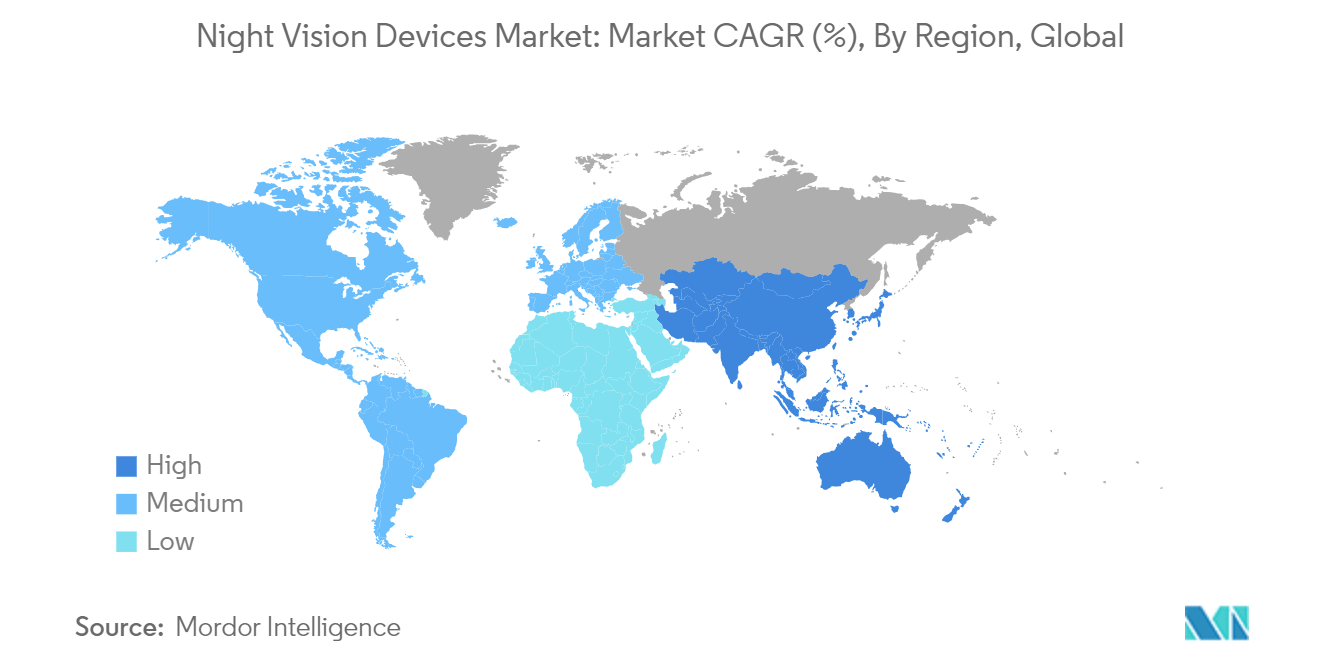Market Trends of Night Vision Devices Industry
Surveillance Applications to Hold Significant Share
- Night vision devices are crucial gadgets of armed forces, and most modern armies equip each of their soldiers with these devices. Night vision aids military forces in defending an area or scanning for threats, such as tanks or persons wishing to harm them. Because the light reflects off the landscape, everything appears to have a greenish hue while utilizing these devices.
- In automotive, night vision has become increasingly commonly used in the civilian market. In bad weather conditions or at night, automotive night vision systems can increase a driver's perception and viewing distance. Typically, they capture data via infrared or thermal imaging, which is occasionally paired with active illumination techniques, and then show it to the driver. Night vision has also been used in aircraft and helicopters, low-light hunting, and night shooting competitions.
- Recently, SWIR or short-wavelength Infrared Night Vision Camera systems have been used for vehicle navigation. Military ground transport vehicles such as trucks, tanks, and armored personnel carriers must operate in complete darkness, increasing the demand for Enhanced Vision Systems (EVS) with short-wave Infrared (SWIR) illumination and sensors. Infinite short wave infrared night vision camera systems to maneuver discreetly through dangerous territory. SWIR cameras, unlike MWIR and LWIR, can image through the windshield, allowing them to be positioned in the driver's compartment for a "driver's eye" view of the road ahead. Ruggedized outside housings can also accommodate SWIR cameras.
- In January 2024, KYOCERA SLD Laser, Inc. (KSLD), a company in the commercialization of laser light sources, introduced its new LaserLight capabilities, including InGaN Laser Diodes for Applications in the Visible Spectral Range. The company is pioneering LiFi innovations for undersea, defense, and security applications.
- The laserlight module-based headlight offers high-brightness white and infrared (IR) dual illumination for night vision and sensing. The company's laserlight LiFi system offers white and IR illumination with a 1 Gbps bi-directional transmission rate to support the future of wireless connectivity. The blue laser-powered technology expands the system's capability into underwater applications. The laserlight Modules are ultra-compact and have a slim profile with less than a 12.7 mm lens height.
- According to NATO, in 2023, the combined defense expenditure for members of NATO was approximately USD 1.26 trillion, the highest NATO members have collectively spent on defense during the provided period. The growing military expenditure in the various regions also results in the growth of the market under study. Governments are increasingly focusing on improving their military capabilities, thereby providing opportunities for the adoption of night vision devices.
- Such developments are anticipated to propel the growth of the night vision devices market in the military and defense industry during the forecast period.

North America to Hold Significant Market Share
- The increased spending on military and defense in the region has allowed companies to conduct R&D activities, resulting in innovations, enabling them to manage better the safety and security of their people and the borders. Further, increased night vision use in firefighting activities to enhance night-time aerial firefighting capabilities increases the adoption of night vision devices in the region.
- Technological advancements have enabled night vision devices to be integrated with machine learning and Augmented reality to enhance the night vision capabilities of the devices. Further, the US Army recently started training its forces using Enhanced Night Vision Goggle-Binocular (ENVG-B). These goggles provide data and imagery from the battlefield directly to the soldier’s eye. The system includes a high-resolution display, an embedded wireless personal network, a rapid target acquisition system, and Augmented reality algorithms that enhance the night vision capabilities of army personnel.
- In November 2023, Leonardo DRS, Inc. received an order for the production of its next-generation thermal weapon sights for the US Army. The production order for more than USD 134 million was made under the Family of Weapon Sights – Individual (FWS-I) IDIQ contract. FWS-I, a clip-on weapon sight, connects wirelessly to helmet-mounted vision systems, including the enhanced night vision goggle binoculars (ENVG-B) and the integrated visual augmentation system (IVAS). It offers rapid target acquisition capabilities to the soldier. It leverages DRS’ uncooled thermal imaging technology, enabling soldiers to acquire targets day or night and in smoke or fog. The partnership will help the company to continue to deliver this vital technology to the US Army.
- In May 2023, the Federal Aviation Administration (FAA) certified the Erickson Incorporated S-64F Air-Crane helicopter for night vision goggles (NVG) operation. Erickson’s integrated NVG program offers customers increased flexibility and expanded operational capabilities. It ensures that the NVG flight crew maintains accordance with current FAA regulations. The certification will allow the company to increase tactical planning and agility in aerial firefighting and civil protection operations. Further, Erickson also collaborated with Aviation Specialties Unlimited (ASU) to modify S-64F to perform NVG operations.
- Therefore, as the regional governments aim to evolve their night vision capabilities through development, integration, experimentation, laboratory and platform tests, and evaluation with integration with various systems in use, the market in the region is likely to grow.


